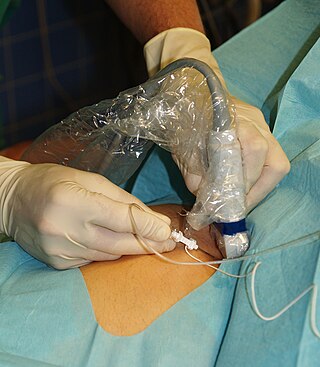Related Research Articles

A local anesthetic (LA) is a medication that causes absence of all sensation in a specific body part without loss of consciousness, as opposed to a general anesthetic, which eliminates all sensation in the entire body and causes unconsciousness. Local anesthetics are most commonly used to eliminate pain during or after surgery. When it is used on specific nerve pathways, paralysis also can be induced.

Lidocaine, also known as lignocaine and sold under the brand name Xylocaine among others, is a local anesthetic of the amino amide type. It is also used to treat ventricular tachycardia. When used for local anaesthesia or in nerve blocks, lidocaine typically begins working within several minutes and lasts for half an hour to three hours. Lidocaine mixtures may also be applied directly to the skin or mucous membranes to numb the area. It is often used mixed with a small amount of adrenaline (epinephrine) to prolong its local effects and to decrease bleeding.

Threading is a method of hair removal for both men and women originating in India and Central Asia. It has gained popularity in Western countries, especially with a cosmetic application.

Reduction mammoplasty is the plastic surgery procedure for reducing the size of large breasts. In a breast reduction surgery for re-establishing a functional bust that is proportionate to the woman's body, the critical corrective consideration is the tissue viability of the nipple–areola complex (NAC), to ensure the functional sensitivity and lactational capability of the breasts. The indications for breast reduction surgery are three-fold – physical, aesthetic, and psychological – the restoration of the bust, of the woman's self-image, and of her mental health.
Lidocaine/prilocaine is a eutectic mixture of equal quantities of lidocaine and prilocaine. A 5% emulsion preparation, containing 2.5% each of lidocaine/prilocaine, is marketed by APP Pharmaceuticals under the trade name EMLA. As a spray, it is marketed under the name Tempe (PSD502) that can be used by men to help with premature ejaculation. The spray is manufactured by Plethora Solutions and branded as Fortacin in the UK and Recordati in the EU.

Lipedema is a condition that is almost exclusively found in women and results in enlargement of both legs due to deposits of fat under the skin. Women of any weight may develop lipedema and the fat associated with lipedema is resistant to traditional weight-loss methods. There is no cure for the condition, which typically gets worse over time. Pain may be present, and patients bruise easily. Over time, mobility may be reduced, and the reduced quality of life often causes patients to experience depression. In severe cases the trunk and upper body may be involved. Lipedema is commonly misdiagnosed and is now becoming known as lipoalgia because there is being no edema.

Sclerotherapy is a procedure used to treat blood vessel malformations and also malformations of the lymphatic system. A medicine is injected into the vessels, which makes them shrink. It is used for children and young adults with vascular or lymphatic malformations. In adults, sclerotherapy is often used to treat spider veins, smaller varicose veins, hemorrhoids, and hydroceles.
Gluteoplasty denotes the plastic surgery and the liposuction procedures for the correction of the congenital, traumatic, and acquired defects and deformities of the buttocks and the anatomy of the gluteal region; and for the aesthetic enhancement of the contour of the buttocks.

Nerve block or regional nerve blockade is any deliberate interruption of signals traveling along a nerve, often for the purpose of pain relief. Local anesthetic nerve block is a short-term block, usually lasting hours or days, involving the injection of an anesthetic, a corticosteroid, and other agents onto or near a nerve. Neurolytic block, the deliberate temporary degeneration of nerve fibers through the application of chemicals, heat, or freezing, produces a block that may persist for weeks, months, or indefinitely. Neurectomy, the cutting through or removal of a nerve or a section of a nerve, usually produces a permanent block. Because neurectomy of a sensory nerve is often followed, months later, by the emergence of new, more intense pain, sensory nerve neurectomy is rarely performed.

Articaine is a dental amide-type local anesthetic. It is the most widely used local anesthetic in a number of European countries and is available in many countries. It is the only local anaesthetic to contain a thiophene ring, meaning it can be described as 'thiophenic'; this conveys lipid solubility.

Prilocaine is a local anesthetic of the amino amide type first prepared by Claes Tegner and Nils Löfgren. In its injectable form, it is often used in dentistry. It is also often combined with lidocaine as a topical preparation for dermal anesthesia, for treatment of conditions like paresthesia. As it has low cardiac toxicity, it is commonly used for intravenous regional anaesthesia (IVRA).
Ambulatory phlebectomy is a minisurgical treatment for superficial varicose veins and so-called side branches.
A brachioplasty, commonly called an arm lift, is a surgical procedure to reshape and provide improved contour to the upper arms and connecting area of chest wall. Although "brachioplasty" is commonly used to describe a specific procedure for the upper arms, the term can also be used to describe any surgical arm contouring. Brachioplasty is often used to address issues such as excessive loose skin or excessive fat in the arms when it does not respond well to diet and exercise. Brachioplasty is a common procedure for patients who have experienced massive weight loss and has gained popularity since 2000.
Dental anesthesia is the application of anesthesia to dentistry. It includes local anesthetics, sedation, and general anesthesia.
Jeffrey Alan Klein M.D., is an American dermatologist from Southern California, who described the tumescent technique for liposuction surgery in 1987, which according to Jayashree Venkataram "revolutionized liposuction surgery" by "permit[ting] liposuction totally by local anaesthesia and with minimal blood loss." He is the author of Tumescent Technique: Tumescent Anesthesia & Microcannular Liposuction, a textbook on liposuction safety and effectiveness.

Liposuction, or simply lipo, is a type of fat-removal procedure used in plastic surgery. Evidence does not support an effect on weight beyond a couple of months and does not appear to affect obesity-related problems. In the United States, liposuction is the most common cosmetic surgery.
TAC stands for tetracaine, adrenaline, and cocaine, it was introduced by Pryor et al. in 1980. TAC is a topical anesthetic solution for local anesthesia and is recommended for use on pediatric patients.
Non-surgical rhinoplasty is a medical aesthetic procedure in which injectable fillers, most commonly hyaluronic acid ones like Restylane and Juvederm or calcium hydroxyapatite (Radiesse), are used to alter and shape a person's nose without a surgery. The procedure fills in depressed areas on the nose, lifting the angle of the tip or smoothing the appearance of bumps on the bridge. Non surgical rhinoplasty is an augmentation procedure, so it cannot reduce the size of someone's nose. The cosmetic procedure carries the risk of causing serious skin damage or distant complications like blindness. If the filler product is injected into an artery, filler can travel in the arteries and blocks smaller size arteries like ophthalmic artery and cause blindness. If blood vessels of the skin is blocked, skin necrosis can develop. Hyaluronic acid based fillers can be reversed even if injected into a blood vessel with an enzyme called hyaluronidase, which can be also injected like fillers.
Tumescent liposuction is a technique that provides local anesthesia to large volumes of subcutaneous fat and thus permits liposuction.
Azadeh Shirazi is an American surgeon and cosmetic dermatologist who has been featured on the DoctorsTV show for being the creator of the Eyeglow procedure. She has authored numerous peer-reviewed journal articles and is also invited on national and local news networks such as FoxNews, Cheddar, NewsMax, NBC, KUSI to discuss various medical topics, therapies, and aesthetic trends.
References
- ↑ Klein, J(2000). "About the Author". Tumescent Technique: Tumescent Anesthesia & Microcannular Liposuction. St. Louis, Missouri: Mosby, Inc, 2000.
- ↑ Rudolph H. De Jong. International Journal of Cosmetic Surgery and Aesthetic Dermatology. March 1, 2002, 4(1): 3-7. doi : 10.1089/153082002320007412.
- 1 2 3 "Tumescent local anesthesia: Recommendations | American Academy of Dermatology". www.aad.org. Retrieved 2019-05-18.
- ↑ Klein, J. A. (November 1993). "Tumescent technique for local anesthesia improves safety in large-volume liposuction". Plastic and Reconstructive Surgery. 92 (6): 1085–1098, discussion 1099–1100. doi:10.1097/00006534-199311000-00014. ISSN 0032-1052. PMID 8234507.
- ↑ Burk, R. W.; Guzman-Stein, G.; Vasconez, L. O. (June 1996). "Lidocaine and epinephrine levels in tumescent technique liposuction". Plastic and Reconstructive Surgery. 97 (7): 1379–1384. doi:10.1097/00006534-199606000-00009. ISSN 0032-1052. PMID 8643720. S2CID 39815212.
- ↑ Klein, J. A. (March 1990). "Tumescent technique for regional anesthesia permits lidocaine doses of 35 mg/kg for liposuction". The Journal of Dermatologic Surgery and Oncology. 16 (3): 248–263. doi:10.1111/j.1524-4725.1990.tb03961.x. ISSN 0148-0812. PMID 2179348.
- ↑ Ostad, A.; Kageyama, N.; Moy, R. L. (November 1996). "Tumescent anesthesia with a lidocaine dose of 55 mg/kg is safe for liposuction". Dermatologic Surgery. 22 (11): 921–927. doi:10.1111/j.1524-4725.1996.tb00634.x. ISSN 1076-0512. PMID 9063507. S2CID 24118936.
- ↑ Kendler, Michael; Simon, Jan C.; Wetzig, Tino (June 2013). "Local anesthesia with lidocaine and prilocaine, using the tumescent technique, for the radiofrequency ablation of lower extremity varicose veins". International Journal of Dermatology. 52 (6): 739–744. doi:10.1111/ijd.12025. ISSN 1365-4632. PMID 23621295. S2CID 25721969.
- 1 2 Augustin, Matthias; Maier, Kristina; Sommer, Boris; Sattler, Gerhard; Herberger, Katharina (2010). "Double-blind, randomized, intraindividual comparison study of the efficacy of prilocaine and lidocaine in tumescent local anesthesia". Dermatology (Basel). 221 (3): 248–252. doi:10.1159/000319753. ISSN 1421-9832. PMID 20881359. S2CID 41394654.
- ↑ Breuninger, H.; Hobbach, P. S.; Schimek, F. (October 1999). "Ropivacaine: an important anesthetic agent for slow infusion and other forms of tumescent anesthesia". Dermatologic Surgery. 25 (10): 799–802. doi:10.1046/j.1524-4725.1999.99087.x. ISSN 1076-0512. PMID 10594583.